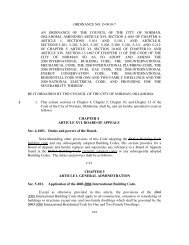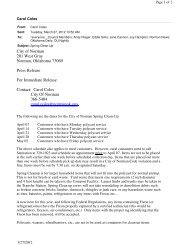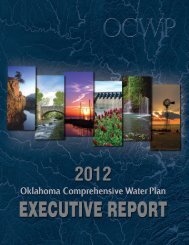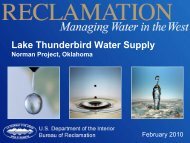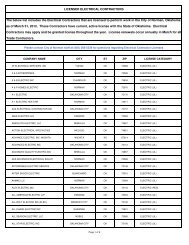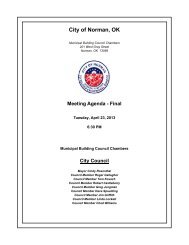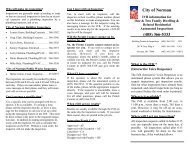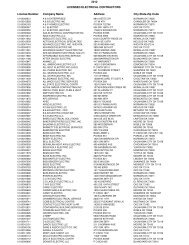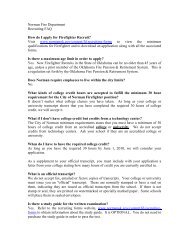2011 Water Conservation Plan - City of Norman
2011 Water Conservation Plan - City of Norman
2011 Water Conservation Plan - City of Norman
Create successful ePaper yourself
Turn your PDF publications into a flip-book with our unique Google optimized e-Paper software.
<strong>City</strong> <strong>of</strong> <strong>Norman</strong><strong>Water</strong> <strong>Conservation</strong> <strong>Plan</strong> <strong>2011</strong>Table <strong>of</strong> ContentsTABLE OF CONTENTS .............................................................................................................. iLIST OF FIGURES ..................................................................................................................... iiiLIST OF TABLES ....................................................................................................................... ivLIST OF APPENDICIES..............................................................................................................v1.0 HISTORY OF THE CITY OF NORMAN WATER SYSTEM.....................................12.0 WATER SYSTEM INVENTORY....................................................................................22.1 <strong>Water</strong> Wells ............................................................................................................22.2 <strong>Water</strong> Treatment <strong>Plan</strong>t .........................................................................................32.3 OKC Emergency Connection................................................................................33.0 WATER RIGHTS VS PRODUCTION ...........................................................................33.1 <strong>Water</strong> Supply Permitted Rights - Wells...............................................................33.2 <strong>Water</strong> Supply Permitted Rights – Surface <strong>Water</strong> ..............................................43.3 <strong>Water</strong> Production...................................................................................................44.0 WATER CUSTOMER PROFILE ...................................................................................44.1 Population...............................................................................................................54.2 Customer Distribution...........................................................................................55.0 WATER USE PROFILE / RATES ..................................................................................55.1 Per Capita Consumption Data..............................................................................55.2 <strong>Water</strong> Pricing Structure........................................................................................76.0 SYSTEM LOSS PROFILE ...............................................................................................86.1 <strong>Water</strong> Treatment System Loss .............................................................................86.2 Distribution System Loss.......................................................................................87.0 WATER MANAGEMENT ...............................................................................................87.1 <strong>Water</strong> Use Issues ....................................................................................................87.2 <strong>Water</strong> Use Goal ....................................................................................................107.3 Indoor Use and Ideas for Reduction ..................................................................107.4 Outdoor Use and Ideas for Reduction ...............................................................117.5 <strong>City</strong> <strong>of</strong> <strong>Norman</strong> <strong>Water</strong> <strong>Conservation</strong> Measures ...............................................138.0 SELECTED MEASURES AND PROJECTED RESULTS.........................................148.1 Continuance <strong>of</strong> Current Fundamental <strong>Water</strong> <strong>Conservation</strong> Measures .........148.2 Projected Results <strong>of</strong> <strong>Conservation</strong> Efforts ........................................................14i
<strong>City</strong> <strong>of</strong> <strong>Norman</strong><strong>Water</strong> <strong>Conservation</strong> <strong>Plan</strong> <strong>2011</strong>9.0 EDUCATIONAL INFORMATION..................................................................................149.1 Media Campaign..................................................................................................149.2 School Programs ..................................................................................................159.3 Information and Education Program ................................................................159.4 <strong>Water</strong> <strong>Conservation</strong> Coordinator ......................................................................1610.0 MANDATORY WATER CONSERVATION MEASURES............................................1610.1 Drought Contingency <strong>Plan</strong>..................................................................................1711.0 ENVIRONMENTAL REVIEW ....................................................................................... 1912.0 ADOPTION AND IMPLEMENTATION.........................................................................20ii
<strong>City</strong> <strong>of</strong> <strong>Norman</strong><strong>Water</strong> <strong>Conservation</strong> <strong>Plan</strong> <strong>2011</strong>List <strong>of</strong> FiguresFigure 1 – <strong>City</strong> <strong>of</strong> <strong>Norman</strong>, Existing <strong>Water</strong> Supply Sources .....................................................2Figure 2 – <strong>City</strong> <strong>of</strong> <strong>Norman</strong>, Liquid Treatment Process Flow Diagram ....................................3Figure 3 – <strong>City</strong> <strong>of</strong> <strong>Norman</strong>, <strong>Water</strong> Production by Source .........................................................4Figure 4 – <strong>City</strong> <strong>of</strong> <strong>Norman</strong>, Per Capita Usage.............................................................................6Figure 5 – Oklahoma Climatological Survey, Annual Precipitation History ..........................7Figure 6 – <strong>City</strong> <strong>of</strong> <strong>Norman</strong>, Historical Demand for Lake Thunderbird...................................9Figure 7 – American <strong>Water</strong> Works Association, 1999 Residential End Uses <strong>of</strong> <strong>Water</strong> ........10Figure 8 – Oklahoma Mesonet, Simple Irrigation <strong>Plan</strong> ...........................................................12Figure 9 – <strong>City</strong> <strong>of</strong> <strong>Norman</strong>, Treated Effluent Application.......................................................13Figure 10 – NOAA, U.S. Seasonal Drought Outlook................................................................16iii
<strong>City</strong> <strong>of</strong> <strong>Norman</strong><strong>Water</strong> <strong>Conservation</strong> <strong>Plan</strong> <strong>2011</strong>List <strong>of</strong> TablesTable 1 – <strong>City</strong> <strong>of</strong> <strong>Norman</strong>, Historic Total Population ................................................................5Table 2 – <strong>City</strong> <strong>of</strong> <strong>Norman</strong>, <strong>Water</strong> Use Customer Summary for <strong>2011</strong>.......................................5Table 3 – <strong>City</strong> <strong>of</strong> <strong>Norman</strong>, Historical Per Capita Consumption <strong>of</strong> <strong>Water</strong> ...............................6Table 4 – <strong>City</strong> <strong>of</strong> <strong>Norman</strong>, Residential <strong>Water</strong> Rates ..................................................................7Table 5 – <strong>City</strong> <strong>of</strong> <strong>Norman</strong>, Non-Residential <strong>Water</strong> Rates..........................................................8iv
<strong>City</strong> <strong>of</strong> <strong>Norman</strong><strong>Water</strong> <strong>Conservation</strong> <strong>Plan</strong> <strong>2011</strong>List <strong>of</strong> AppendicesAppendix A – <strong>City</strong> <strong>of</strong> <strong>Norman</strong> Resolution R-0203-99v
<strong>City</strong> <strong>of</strong> <strong>Norman</strong><strong>Water</strong> <strong>Conservation</strong> <strong>Plan</strong> <strong>2011</strong>1.0 HISTORY OF THE CITY OF NORMAN WATER SYSTEMSettlement <strong>of</strong> public lands near the Little River and the South Canadian River in centralOklahoma progressed rapidly once the area was opened to entry in the late 1800’s. In this area,the once known settlement called Camp <strong>Norman</strong> was incorporated into the <strong>City</strong> <strong>of</strong> <strong>Norman</strong> onMay 13, 1891. Since its incorporation, the <strong>City</strong> <strong>of</strong> <strong>Norman</strong> has continually expanded. Aboutthis same time, the State <strong>of</strong> Oklahoma established the University <strong>of</strong> Oklahoma in <strong>Norman</strong>. Sincethen, our histories have traveled together.For the first 65 years <strong>of</strong> our history, <strong>Norman</strong>’s water supply was from wells drilled into theGarber Wellington Aquifer located beneath central Oklahoma. The aquifer ranges South toNorth from <strong>Norman</strong> to Guthrie. The aquifer ranges west to east from I-35 to Shawnee. In the1940’s, city <strong>of</strong>ficials began to realize the need for additional water resources which led todiscussions with the Bureau <strong>of</strong> Reclamation and the ultimate reconnaissance study for a reservoirin 1949.A Feasibility Study followed in 1954, a Reappraisal Report in 1959, and a Definite <strong>Plan</strong> Reportin 1961. These all led the Federal Government to the conclusion that a surface reservoir wasneeded to serve area communities. The reservoir was named The <strong>Norman</strong> Project, eventually tobecome Lake Thunderbird and was authorized by Congress on June 27, 1960. The <strong>Norman</strong>Project considered serving Oklahoma <strong>City</strong>, Tinker Air Force Base, <strong>Norman</strong>, Midwest <strong>City</strong> andDel <strong>City</strong>. Oklahoma <strong>City</strong> realized the quantity was too small for their efforts. Tinker decided tostay with their wells which left the supply for <strong>Norman</strong>, Midwest <strong>City</strong>, and Del <strong>City</strong>. Threemembers from <strong>Norman</strong>, 3 members from Midwest <strong>City</strong>, and 1 member from Del <strong>City</strong> wereappointed to form the Central Oklahoma Master Conservancy District (COMCD) in 1961. Theirpurpose was to manage the needs <strong>of</strong> all project participants. The lake was designed to yield areliable water supply at 21,600 acre feet per year or approximately 7 billion gallons per year.The contract stated that <strong>Norman</strong> would receive 43.8%, MWC 40.4%, and Del <strong>City</strong> 15.8%.Throughout this time the lake and the water wells were continually used to supply its citizens asneeded. In the 1970’s increased peak day water demand was stressing the system. In 1982 thewater treatment plant was expanded from 7 MGD to 14 MGD. Though this did not expand ourannual allocation <strong>of</strong> water from Lake Thunderbird, it allowed the plant to replenish the waterused after peak day demands experienced in the summertime. As the population and associatedwater demands expanded over time, this led to water shortages and rationing in the 1990’s for<strong>Norman</strong>. Additional water wells began to be constructed and in 1999, 31 wells along with a 14MGD water treatment plant were being utilized to meet <strong>Norman</strong>’s demand.In 2000, <strong>Norman</strong> completed a connection to the treated water supply system <strong>of</strong> Oklahoma <strong>City</strong>.This connection served and continues to serve as an emergency reserve supply and is onlyoperated during times <strong>of</strong> extreme demand or system emergency. <strong>Norman</strong> produces its own waterfrom the lake and wells at a much lower cost than purchasing water from Oklahoma <strong>City</strong> so it ismore economical for <strong>Norman</strong> to purchase the additional water needed using Oklahoma <strong>City</strong>’sPeak Rate.In January <strong>of</strong> 2006, the arsenic rule became in effect which lowered the arsenic limits from 50micrograms per liter to 10 micrograms per liter. This lower limit forced the <strong>City</strong> to turn <strong>of</strong>fseveral wells and <strong>Norman</strong>’s water supply was reduced to 15 active wells along with the waterfrom Lake Thunderbird. This same year, the citizens <strong>of</strong> <strong>Norman</strong> voted to significantly raise theirwater rates in order to address the impacts <strong>of</strong> the lowering <strong>of</strong> the arsenic limits. With the rate1
<strong>City</strong> <strong>of</strong> <strong>Norman</strong><strong>Water</strong> <strong>Conservation</strong> <strong>Plan</strong> <strong>2011</strong>increase, new wells were drilled within Northeast <strong>Norman</strong>. Also, large irrigation users werereviewed in an effort to replace their potable water needs with irrigation quality water. <strong>Norman</strong>began encouraging citizens to practice conservation every day.2.0 WATER SYSTEM INVENTORY2.1 <strong>Water</strong> Wells Today, <strong>Norman</strong> utilizes Lake Thunderbird and 26 water wells drilled into theGarber Wellington Aquifer to meet everyday water needs. An additional 10 wells are scheduledto come online August 1, <strong>2011</strong> which will increase our well field to 36 wells. Ground water ispumped from the Garber Wellington Aquifer directly into <strong>Norman</strong>’s water distribution systemwith the exception <strong>of</strong> three wells. Of the three considered treated, two are blended with otherwater sources to meet the arsenic rule. One well has a pilot arsenic removal system set up withchloramination. The remainder <strong>of</strong> the wells meet current water quality standards with outadditional treatment. Feasibility data is being collected to possibly combine several wells that arenot active and establish a combined treatment system to reduce arsenic levels. <strong>City</strong> staffcontinues to monitor updates to the ground water rule and unregulated contaminants that mightbe added in the future.Figure 1 graphically shows the general distribution <strong>of</strong> the water wells, including those recentlyclosed due to high arsenic, and their physical relation to Lake Thunderbird.Figure 1.2
<strong>City</strong> <strong>of</strong> <strong>Norman</strong><strong>Water</strong> <strong>Conservation</strong> <strong>Plan</strong> <strong>2011</strong>2.2 <strong>Water</strong> Treatment <strong>Plan</strong>t Raw water is delivered by the COMCD to <strong>Norman</strong>’s water treatmentplant. <strong>Plan</strong>t design is conventional s<strong>of</strong>tening and it was constructed in the mid 1960’s. The plantwas upgraded in 1982 and is currently undergoing improvements. Figure 2 is the futuretreatment process for <strong>Norman</strong>’s water treatment plant.Figure 2.2.3 OKC Emergency Connection The supply line connecting <strong>Norman</strong> to Oklahoma <strong>City</strong> providesan emergency supply source. Maximum delivery rate can vary from 6.5 to 9 MGD depending onseason and ultimately the pressure differential between Oklahoma <strong>City</strong> and <strong>Norman</strong>. This sourceis a last resort supply since its cost is greater than what <strong>Norman</strong>’s rate structure will support on acontinual basis. The vault connection is located at the northwest boundary <strong>of</strong> <strong>City</strong> limits.3.0 WATER RIGHTS vs PRODUCTION3.1 <strong>Water</strong> Supply Permitted Rights- Wells A majority <strong>of</strong> <strong>Norman</strong>’s ground water right permitsare temporary permits which allow withdrawal <strong>of</strong> 2 acre-ft <strong>of</strong> water per acre per year. <strong>Norman</strong> ispermitted for approximately 28,600 acre-ft <strong>of</strong> ground water which equates to roughly 9.3 billiongallons per year. The Garber-Wellington aquifer is currently being studied by the Oklahoma<strong>Water</strong> Resources Board and the Association <strong>of</strong> Central Oklahoma Governments (ACOG).Preliminary data suggests that the sustainable yield is much less than the current water rightsissued under temporary permits. ACOG indicates the recharge rate is approximately 2 inches peryear which suggests that the sustainable yield will probably be between 0.25 and 0.5 acre-ft <strong>of</strong>water per year. If the decision is made to reduce the yield to 0.5 acre-ft <strong>of</strong> water per year, theNUA’s water rights will be 2.33 billion gallons per year or an average <strong>of</strong> 6.4 Million Gallons perDay (MGD). This reduced yield would only allow for 36 wells operating 70% <strong>of</strong> the timethroughout the year. Therefore, if the temporary permits are reduced before becoming finalpermits, additional ground water rights will be necessary.3
<strong>City</strong> <strong>of</strong> <strong>Norman</strong><strong>Water</strong> <strong>Conservation</strong> <strong>Plan</strong> <strong>2011</strong>3.2 <strong>Water</strong> Supply Permitted Rights-Surface <strong>Water</strong> <strong>Norman</strong>’s surface water comes from LakeThunderbird which is controlled by the Central Oklahoma Master Conservancy District.<strong>Norman</strong> is permitted to use an allotment <strong>of</strong> 3.083 billion gallons per year. This equates to anaverage <strong>of</strong> 8.4 MGD. The <strong>Norman</strong> water treatment plant and raw water supply line had amaximum daily capacity <strong>of</strong> 14 MGD until <strong>2011</strong> when it was expanded to 17 MGD. However,since the annual average must remain at 8.4 MGD or less, <strong>Norman</strong> must use less surface water inthe winter months to allow for the additional demand in the summer months.3.3 <strong>Water</strong> Production Daily records are kept on the operations <strong>of</strong> each source <strong>of</strong> supply. Figure3 represents the annual water usage from the three sources available to <strong>Norman</strong>. The Oklahoma<strong>City</strong> supply connection became available in Summer 2000 and is an important part <strong>of</strong> our currentsummer peaksupply.Figure 3.4.0 WATER CUSTOMER PROFILE<strong>Norman</strong> is not a heavily industrialized community. Residential customers consume the majority<strong>of</strong> the water produced. Within <strong>Norman</strong> are five purchase water systems operating individually.The University <strong>of</strong> Oklahoma is the largest followed by Griffin Memorial Hospital followed bythree mobile home parks.<strong>Water</strong> demand is influenced by the population served, per capita water use, weather conditionsand conservation measures, while the water supply capability is largely a matter <strong>of</strong> the resourcesavailable. To assess <strong>Norman</strong>’s ability to meet future needs, the 2040 Strategic <strong>Water</strong> Supply<strong>Plan</strong> was developed to address water system improvements and expansion needs based onprojected trends in usage. These efforts were based on historical data collected from <strong>Norman</strong>’soperational and growth records. Though the <strong>Water</strong> Supply <strong>Plan</strong> projected continued gallon percapita day (gpcd) increases, <strong>Norman</strong> staff has refined earlier projections and tapered forecastsdown from original projections.4
<strong>City</strong> <strong>of</strong> <strong>Norman</strong><strong>Water</strong> <strong>Conservation</strong> <strong>Plan</strong> <strong>2011</strong>4.1 Population <strong>Norman</strong>’s continual growth since 1890 is reflected in Table 1. The data providedin Table 1 originated from the United States Census Bureau.Table 1 – <strong>City</strong> <strong>of</strong> <strong>Norman</strong>, Historic Total PopulationYearTotalPopulation1890 7871900 2,2251910 3,7241920 5,0041930 9,6031940 11,4291950 27,0061960 33,4121970 52,1171980 68,0201990 80,0712000 96,0652005 101,9302010 110,9254.2 Customer Distribution The <strong>City</strong> <strong>of</strong> <strong>Norman</strong> delivers water to retail customers inside the <strong>City</strong>Limits. Table 2 provides a customer summary for the <strong>City</strong> <strong>of</strong> <strong>Norman</strong> in <strong>2011</strong>. It is worth notingthe <strong>City</strong> <strong>of</strong> <strong>Norman</strong>, unlike most cities, does not have a reserve water supply to meet futureindustrial ventures should a company want to relocate their business to <strong>Norman</strong>.Table 2 – <strong>City</strong> <strong>of</strong> <strong>Norman</strong>, <strong>Water</strong> Use Customer Summary in <strong>2011</strong>Category# <strong>of</strong> AccountsResidential 32,500Commercial 1,848Industrial 17Institutional 45<strong>City</strong> <strong>of</strong> <strong>Norman</strong> 88Irrigation Only 716OU 34Total Customers 35,2485.0 WATER USE PROFILE / RATES<strong>Water</strong> customers in <strong>Norman</strong> exhibit distinctive use patterns. Each category <strong>of</strong> user describedbelow illustrates the nature <strong>of</strong> each customer category use pattern.5.1 Per Capita Consumption Data Per capita consumption is determined by dividing the totalwater produced in a given year, divided by the population served, then divided by 365 days peryear. Table 3 provides the calculated per capita information available from 1960 to 2010.5
<strong>City</strong> <strong>of</strong> <strong>Norman</strong><strong>Water</strong> <strong>Conservation</strong> <strong>Plan</strong> <strong>2011</strong>Table 3 – <strong>City</strong> <strong>of</strong> <strong>Norman</strong>, Historical Capita Consumption <strong>of</strong> <strong>Water</strong>YearPer CapitaConsumption(gpcd)1960 741970 811980 1001985 1211990 1331995 1392000 1422001 1422002 1332003 1342004 1302005 1422006 1552007 1322008 1302009 1222010 125Values presented in Table 3 represent experienced demands. Though data from 1960 forwardshows an increasing trend, data since 1990 indicate no significant change. Figure 4 belowillustrates these trends.Average Gallons per Person per Daygpcd1801601401201008060402001950 1960 1970 1980 1990 2000 2010 2020Calendar Yeargpcd since 1960 gpcd since 1990Linear (gpcd since 1990) Linear (gpcd since 1960)Figure 4.6
<strong>City</strong> <strong>of</strong> <strong>Norman</strong><strong>Water</strong> <strong>Conservation</strong> <strong>Plan</strong> <strong>2011</strong>It is expected that per capita consumption will increase with climate / weather. Data from theOklahoma Climatological Survey is presented in Figure 5 below. It shows that Oklahoma hasbeen in a period <strong>of</strong> above average rainfall since about 1983, which may account for the flattening<strong>of</strong> the water use trend. The state average water use is near 180 gpcd, indicating that <strong>Norman</strong> hasalready achieved significant water conservation. Further water conservation will probably bemore difficult, and if Oklahoma enters a dry weather trend the increase may outweigh thesavings that may be achieved.Figure 55.2 <strong>Water</strong> Pricing Structure The water rate structure in <strong>Norman</strong> is established by a majority vote<strong>of</strong> the public. The city charter prohibits increasing water rates by administrative action. Thevoters established the water rates currently in effect in 2006. Table 4 presents the water ratescurrently established for residential customers.Table 4 – <strong>City</strong> <strong>of</strong> <strong>Norman</strong>, Residential <strong>Water</strong> RatesVolumeUnit CostBase Rate $4.000 to 5,000 gallons $2.00 per 1,000 gallons5,001 to 15,000 gallons $2.10 per 1,000 gallons15,001 to 20,000 gallons $2.75 per 1,000 gallons20,001 or more gallons $4.95 per 1,000 gallonsThe voters <strong>of</strong> <strong>Norman</strong> also establish the water rates for non-residential. Table 5 reflects thewater rates set for non-residential customers.7
Table 5 – <strong>City</strong> <strong>of</strong> <strong>Norman</strong>, Non-Residential <strong>Water</strong> RatesVolumeUnit CostBase Rate $4.000 or more gallons $2.10 per 1,000 gallons<strong>City</strong> <strong>of</strong> <strong>Norman</strong><strong>Water</strong> <strong>Conservation</strong> <strong>Plan</strong> <strong>2011</strong>The water rates in <strong>Norman</strong> are in effect year round. No seasonal rate applications exist.6.0 SYSTEM LOSS PROFILEUtilities staff continually monitors percent loss within the water distribution system. Utilizing a12 month running average, <strong>Norman</strong>’s unaccounted water ranges from 10 – 12%.6.1 <strong>Water</strong> Treatment System Loss Raw water is delivered to <strong>Norman</strong>’s water treatment plant bythe Central Oklahoma Master Conservancy District. Line losses in their delivery system areunknown. Losses within the boundaries <strong>of</strong> the treatment plant are thought to be minimal. Recentflow meters have been installed with the plant rehabilitation that will better track waterinventories. Losses are usually attributed to the evaporation <strong>of</strong> filter backwash process water asit is held for extended periods in the residual ponds.6.2 Distribution System Loss As mentioned earlier, system losses are believed to be in the order<strong>of</strong> 10-12%. To minimize this value, line maintenance personnel are available 24 hours a day toaddress system failures as they occur. Nightime crews perform routine tasks until needed forwaterline failure. Upon being notified <strong>of</strong> a failure, they respond with quick corrective action.Another known source <strong>of</strong> water loss within the distribution system is from old and or fatiguedwater meters. The older meters have propellers that spin and account for the water used. Thepropellers deteriorate over time and are not able to register all <strong>of</strong> the water delivered to thecustomers. Line maintenance crews routinely test, remove and replace meters in an effort toimprove water accountability. Approximately 550 meters are replaced annually <strong>of</strong> the 35,248total meters. This equates to a replacement cycle <strong>of</strong> once every 64 years. American <strong>Water</strong>Works Association recommends a replacement cycle <strong>of</strong> small meters once per 10 years andsuggest to annually check large meters accuracy since these usually register larger amounts <strong>of</strong>water used in the water system.7.0 WATER MANAGEMENT<strong>Water</strong> Management for the <strong>City</strong> <strong>of</strong> <strong>Norman</strong> is very important, considering the historic increasesin customer usage along with a growing population. The combination <strong>of</strong> growth, a slightlyincrease <strong>of</strong> customer usage and most importantly a limited local water supply lead to significantwater supply problems in the very near future. Recent conservation efforts have resulted in adecrease in per meter usage while the population has increased. However, additional supply isnecessary in addition to continued conservation efforts.7.1 <strong>Water</strong> Use Issues <strong>Norman</strong> utilizes Lake Thunderbird as its source <strong>of</strong> surface water supply. Inaddition to this, water wells into the Garber Wellington aquifer provide the other component <strong>of</strong>8
<strong>City</strong> <strong>of</strong> <strong>Norman</strong><strong>Water</strong> <strong>Conservation</strong> <strong>Plan</strong> <strong>2011</strong>water supply. Each source is currently experiencing problems with either quantity capability orquality.Since the 1960’s, Lake Thunderbird has historically served the majority <strong>of</strong> <strong>Norman</strong>’s waterdemand needs. The annual allotment from Lake Thunderbird is 9,460 acre-feet (3.082 billiongallons). In 1988 <strong>Norman</strong> exceeded the allotment for the first time. Since then, the watertreatment plant use has exceeded the allowed allocation fifteen times. The demands on LakeThunderbird have increased to the point that it cannot provide the <strong>City</strong>’s supply requirements ona continual basis. Figure 6 depicts <strong>Norman</strong> continually increasing demand placed on LakeThunderbird. Only recently efforts were made to operate the well field at a maximum yield toreduce the annual demand from Lake Thunderbird and bring <strong>Norman</strong>’s usage within thepermitted allocation. Projected increases over the next 15 years will only get greater as the cityapproaches 2060.<strong>Norman</strong>'s Lake Thunderbird Usagevs Permitted AllocationMillion Gallons5,0004,0003,0002,0001,00001960 1970 1980 1990 2000 2010 2020<strong>Water</strong> Year (Oct - Sep)UsageAllocationFigure 6.To reduce the demands on Lake Thunderbird, <strong>Norman</strong> began to rely heavily on water productionfrom ground water wells to meet demands. This practice allows <strong>Norman</strong> to limit the extent <strong>of</strong>exceeding the Lake Thunderbird allotment annually. It is uncertain at this time if the well fieldcan withstand this increased pumping strategy over time. Additionally, <strong>Norman</strong> must continueto address increased regulations regarding groundwater. The most impacting rule change wasthe one establishing new limits in the amount <strong>of</strong> naturally occurring arsenic. This rule changeresulted in the loss <strong>of</strong> fourteen wells from service. In addition, another well failed fluoridetesting and one structurally failed. By January <strong>of</strong> 2006, the loss <strong>of</strong> these wells reduced <strong>Norman</strong>’stotal ability to supply water to a peak rate <strong>of</strong> 18.4 million gallons per day.Currently, EPA is reviewing the existing regulatory limits for Chromium. If the current 100parts per billion (ppb) regulation is reduced to a limit <strong>of</strong> 10 ppb or less, it will require most <strong>of</strong> thewell field to be shutdown and/or costly treatment added to continue use. EPA has also recently9
<strong>City</strong> <strong>of</strong> <strong>Norman</strong><strong>Water</strong> <strong>Conservation</strong> <strong>Plan</strong> <strong>2011</strong>released candidates for future contaminants <strong>of</strong> concern which include vanadium. Similar to theother metals, the Garber Wellington well field has levels <strong>of</strong> vanadium prevalent as well.7.2 <strong>Water</strong> Use Goal Conserving and reusing water will ultimately save <strong>Norman</strong> citizens moneyand decrease the demands placed upon the environment in the form <strong>of</strong> additional supplies.<strong>Norman</strong> has accomplished much to reduce the growth <strong>of</strong> the per capita usage. To further reduceper capita water usage, a combined effort <strong>of</strong> public education and water pricing will be necessaryto achieve this goal. In all cases, <strong>Norman</strong> will still need additional supplies <strong>of</strong> water for thefuture.7.3 Indoor Use and Ideas for Reduction Current indoor use patters are shown in the attachedFigure 7.Figure 7.(Source: American <strong>Water</strong> Works Association. (1999). Residential End Uses <strong>of</strong> <strong>Water</strong>)Customers can do their part by conserving water and using water wisely. The <strong>City</strong> has materialavailable on water conservation tips available at the <strong>City</strong> Hall and on the <strong>City</strong> website. Some areincluded here:*Take brief showers and/or open faucets only half or three-quarters open to minimize the totalwater use per shower. Installing a simple restrictor in the shower head or installing a low wateruse shower head can reduce water use by 25 to 35 percent. However, only opening the faucetspart way will accomplish the same thing with no cost or installation required.*Place plastic bottles or bags filled with water and a few stones in the toilet tank to reduce thevolume <strong>of</strong> water used with each flush. There are also alternatives <strong>of</strong> toilet dams or low water usetoilets available. These may reduce the total water used by 5 to 20 gallons per day. However, beaware a newer model is probably already a low water use model, and reducing the volume <strong>of</strong>water per flush may cause improper flushing.*Encourage the use <strong>of</strong> faucet aerators on all kitchen and bathroom faucets, as these reduce thewater flow while enhancing the rinsing action <strong>of</strong> the faucet stream.*Use automatic dishwashers sparingly and only for full loads. Most dishwashers use 20 to 30gallons per wash, and most or all <strong>of</strong> it is hot water. By washing only full loads or hand washing10
<strong>City</strong> <strong>of</strong> <strong>Norman</strong><strong>Water</strong> <strong>Conservation</strong> <strong>Plan</strong> <strong>2011</strong>small amounts, saves in both water and energy. When cleaning dishes for the dishwasher, wipethem <strong>of</strong>f with a paper towel or napkin rather than rinsing; this will save from 3 to 5 gallons.*Wash only full loads <strong>of</strong> clothes, or match the water setting <strong>of</strong> the washer to the size <strong>of</strong> the load.*Keep a bottle <strong>of</strong> water in the refrigerator for a cool drink. Do not run the faucet to chill thewater.7.4 Outdoor Use and Ideas for Reduction There are several ways to reduce outdoor water usage.In the summer months, <strong>Norman</strong> citizens more than double their indoor water usage recorded inthe winter months. Outdoor ideas include:*Use a nozzle with a cut<strong>of</strong>f feature on your garden hose when washing the car or other outdooritems. This will cut <strong>of</strong>f the water flow when not needed.*Sweep driveways or patios rather than hosing them <strong>of</strong>f, unless they border a flower bed orgarden. If so, wash so the water will run to the garden or flower bed. Get double duty from thewater used.*<strong>Plan</strong>t trees, shrubs and ornamentals that are adapted to dry conditions. Use mulch around plantsand shrubs to help limit evaporation and retain water. Use sprinklers sparingly and water afterthe sun goes down to limit evaporation. Where possible, use soaker hoses instead <strong>of</strong> sprinklers,as they are more efficient. Don't over fertilize your lawn, since this will make it require morewater than normal.*If you have a swimming pool, cover it when not in use to control evaporation.Plumbing and Landscaping OrdinancesThe <strong>City</strong> <strong>of</strong> <strong>Norman</strong> Code <strong>of</strong> Ordinances requires the 1997 InternationalPlumbing Code for non-residential construction and 1995 Council <strong>of</strong>American Building Officials for residential construction be observed.Each requires low flow fixtures in new construction.In 2005 the <strong>City</strong> <strong>of</strong> <strong>Norman</strong> began to require that all new automaticirrigation systems have a rain sensor and freeze gauges installed topromote water conservation. This measure will help to reduce theoverall water usage <strong>of</strong> <strong>Norman</strong>.Landscape ProgramsThe <strong>City</strong> <strong>of</strong> <strong>Norman</strong> carefully monitors its own use <strong>of</strong> water utilized in public landscapeimprovements. Irrigation activities only occur when soil conditions require. Attention is givento weather conditions and forcasts in deciding upon irrigation times for public spaces. Manyareas have been switched from spray watering to ground level drip irrigation.As for private landscape programs, <strong>Norman</strong> encourages but does not enforce acceptable times forirrigation to be allowed. Current practice is to provide public reminders through the local press11
<strong>City</strong> <strong>of</strong> <strong>Norman</strong><strong>Water</strong> <strong>Conservation</strong> <strong>Plan</strong> <strong>2011</strong>and as billing inserts about wasteful activities commonly occurring during irrigation. Throughpublic media contact, self guided direction for landscape practices occur.How much should I water my lawn?This question is received from citizens <strong>of</strong>ten and the answer is dependent on several variables.Local universities maintain a website that monitors soil conditions and with the expertise inagronomy, it suggests watering quantities for various lawns. Customers are encouraged to visitthis website provided by Oklahoma and Oklahoma State Universities team partnership.The web site is named SIP, an acronym for ‘Simple Irrigation <strong>Plan</strong>’. http://sip.mesonet.org/Figure 8 above is and example <strong>of</strong> the SIP website.Figure 8.12
<strong>City</strong> <strong>of</strong> <strong>Norman</strong><strong>Water</strong> <strong>Conservation</strong> <strong>Plan</strong> <strong>2011</strong>7.5 <strong>City</strong> <strong>of</strong> <strong>Norman</strong> <strong>Water</strong> <strong>Conservation</strong> Measures Treated wastewater as irrigation reuse occursin <strong>Norman</strong>. The University <strong>of</strong> Oklahoma uses an average <strong>of</strong> 500,000 gallons <strong>of</strong> effluent per dayin the summer to irrigate the golf course. The University installed pumps and piping to connectthe golf course to the discharge line leaving the treatment facility. <strong>Norman</strong> desires to utilize thisresource further in the future. Figure 9 shows a typical effluent application at the University <strong>of</strong>Oklahoma Golf Course. At this time, local state regulations limit the irrigation application <strong>of</strong>effluent to controlled access areas only.Figure 9 – <strong>City</strong> <strong>of</strong> <strong>Norman</strong>Treated Effluent ApplicationSince 2004, <strong>Norman</strong> has implemented a few notable water conservation measures worthmentioning.1. Westwood Golf Course utilized potable water for irrigation since it was built in 1967. Duringsummer time peak demands, the golf course would use the equivalent <strong>of</strong> 1 municipal water wellor 300,000 gallons per day. During the 2004 remodel project, new large ponds were constructedto capture and hold storm water. In addition, the water utility fund aided in drilling a new nonpotableirrigation well for use on the golf course. The irrigation well was purchased forapproximately $300,000 less than the cost <strong>of</strong> a fully designed, DEQ approved drinking waterwell.2. At a cost <strong>of</strong> $15,000, a water well not suitable for drinking water was re-purposed forirrigation only to serve the Griffin park complex. This complex too was dependent on <strong>Norman</strong>’streated water drinking for irrigation purposes. The existing usage was not fully metered so it isestimated that peak summer irrigation days were over 300,000 gallons per day or the equivalent<strong>of</strong> one well during peak summer demands. Now Griffin park complex has a new irrigation pondand a well that can be used to help supply irrigation water.3. Wastewater Treatment <strong>Plan</strong>t constructed a non-potable water system to discontinue usingpotable water for all <strong>of</strong> the maintenance activities, such as washing clarifier weirs, foamsuppression, pump seals, etc.. This is estimated at a savings <strong>of</strong> 480,000 gallons per day or theequivalent <strong>of</strong> 1 and 1/2 wells.13
<strong>City</strong> <strong>of</strong> <strong>Norman</strong><strong>Water</strong> <strong>Conservation</strong> <strong>Plan</strong> <strong>2011</strong>4. During the summer months, potable water is utilized by the composting operation to maintaina continual moist environment during processing. The potable water is used in this operationcurrently to control dust and limit compost drying during warmer periods. Conversion to usetreated wastewater effluent will effectively reduce demands placed on treated water supplies.Staff is working with DEQ to allow the non-potable water to be used for the compostingoperation.8.0 SELECTED MEASURES AND PROJECTED RESULTS<strong>Conservation</strong> efforts undertaken in the last several years have provided a noted reduction in thegrowth <strong>of</strong> the per capita usage <strong>of</strong> water in <strong>Norman</strong>. Through knowledge and understanding, thecitizens <strong>of</strong> <strong>Norman</strong> can continue to reduce their annual per person water demands. In addition tocontinuing existing programs, new efforts will be introduced to further conservation by thecitizens <strong>of</strong> <strong>Norman</strong>.8.1 Continuance <strong>of</strong> Current Fundamental <strong>Water</strong> <strong>Conservation</strong> Measures Efforts underway in<strong>Norman</strong> to conserve water will continue into the future. All existing programs will be continuedas long as funding allows. Efforts to gain citizen’s support <strong>of</strong> water conserving practices will bepursued through all existing measures.8.2 Projected Results <strong>of</strong> <strong>Conservation</strong> Efforts Figure 20 shows the actual per capita increases inpotable water consumption since 1960 yet shows a flat growth from 1990 to current. Staff isuncertain as to how much can be attributed to conservation efforts and or the effects <strong>of</strong> recentclimate patterns. If a growth in demand through adding industry and or extended droughtpatterns develops along with the expanding population sustainability cannot be achieved withcurrent water resources.With additional rate increases <strong>of</strong> the conservation based water rates along with the waterconservation and reuse programs listed within this document, it is projected that waterconsumption can be curtailed. Achieving this goal will affect the timeline <strong>of</strong> implementingwater resource projects. It will not eleminate the future need for additional supplies, but willallow time for detailed consideration to be given to options available.9.0 EDUCATIONAL INFORMATION<strong>Norman</strong> promotes water conservation along with pesticide reduction activities as part <strong>of</strong> theirefforts to promote a cleaner environment. Information is distributed to all water customersseveral times a year through the monthly billing and other avenues.Annually, the <strong>City</strong> <strong>of</strong> <strong>Norman</strong> provides the Consumer Confidence Report to all customers anddwelling units served by <strong>Norman</strong> water. In this, along with all required information, extensiveconservation tips are given for water use in and around households. In 2010,approximately 30,000 reports were delivered to the citizens <strong>of</strong> <strong>Norman</strong>.9.1 Media Campaign To reduce summertime periods <strong>of</strong> high water usage the<strong>City</strong> <strong>of</strong> <strong>Norman</strong>, along with the local newspaper, publishes daily the previousdays overall per capita usage along with a conservation tip. This promotesawareness <strong>of</strong> what demands the citizens’ place on the system when14
<strong>City</strong> <strong>of</strong> <strong>Norman</strong><strong>Water</strong> <strong>Conservation</strong> <strong>Plan</strong> <strong>2011</strong>temperatures are high. In addition, with the help <strong>of</strong> local news agencies, water use awarenessmedia releases occur to notify citizens <strong>of</strong> the need to be responsible for their usage <strong>of</strong> water.Publications have included recommendations to our customers.9.2 School Programs The <strong>Norman</strong> public schools have implemented a Thursday Folder programin the grade schools whereby every Thursday a folder is sent home with each student containingschool information, completed assignments, and public information. Students and parents haveto review the materials together with the folderreturned the following day with the parent’ssignature verifying that the materials werereviewed. Over the last several years, multipledistributions <strong>of</strong> water conservation materialshave been made. In 2005, 6,700 fliers andbookmarks noting conservation and protection<strong>of</strong> our water were distributed through theThursday Folder program.9.3 Information and Education ProgramThe items listed in Section 4.0 outline the basis<strong>of</strong> the information and education program ineffect today in <strong>Norman</strong>. Funds for these actions are provided by the water utility systemrevenues. Future efforts will continue to expand the public’s knowledge <strong>of</strong> voluntary waterconservation practices.Part <strong>of</strong> information and education is using the ‘drought monitor’ web site sponsored by severalstate and federal organizations. This information is posted weekly at the <strong>Water</strong> Treatment <strong>Plan</strong>tto keep track <strong>of</strong> weather patterns, especially related to drought. The web site is;http://drought.unl.edu/dm/monitor.html15
<strong>City</strong> <strong>of</strong> <strong>Norman</strong><strong>Water</strong> <strong>Conservation</strong> <strong>Plan</strong> <strong>2011</strong>Figure 10 above is the screen sample <strong>of</strong> one <strong>of</strong> the pages from the drought web site.Figure 10.9.4 <strong>Water</strong> <strong>Conservation</strong> Coordinator The <strong>City</strong> <strong>of</strong> <strong>Norman</strong> has assigned water conservationinformation distribution and the direction <strong>of</strong> public programs to the Environmental ServicesCoordinator. The responsibilities include coordinating compliance monitoring <strong>of</strong> industrialcustomers, coordinating water pollution educational programs, and water conservation education.The mailing address to the <strong>City</strong> <strong>of</strong> Environmental Services Coordinator follows:<strong>City</strong> <strong>of</strong> <strong>Norman</strong>Environmental Services CoordinatorP.O. Box 370<strong>Norman</strong>, OK 7307010.0 MANDATORY WATER CONSERVATION MEASURESAdditional water conservation measures are utilized when drought patterns begin. The <strong>City</strong>Manager begins with voluntary measures and if conditions persist, must mandate more extrememeasures.16
<strong>City</strong> <strong>of</strong> <strong>Norman</strong><strong>Water</strong> <strong>Conservation</strong> <strong>Plan</strong> <strong>2011</strong>10.1 Drought Contingency <strong>Plan</strong> Triggers for Stage 1, voluntary water conservation. The <strong>City</strong>Manager may implement Stage 1 when one or more <strong>of</strong> the following criteria are met:1. The <strong>City</strong> water demand is expected to equal the NUA’s supply capacity.2. Lake Thunderbird water level drops to a water level <strong>of</strong> 1034.0.3. There is a temporary reduction in the source <strong>of</strong> supply from Lake Thunderbird (i.e. one <strong>of</strong>the supply pumps not operating, break or damage to raw water line, temporarycontamination to water supply).4. A large portion <strong>of</strong> NUA’s water distribution system is temporarily out <strong>of</strong> service due towater main breaks, threat <strong>of</strong> contamination, construction damage, etc.).5. Oklahoma <strong>City</strong> emergency connection is not available for use, due to a water line breakor reduced source <strong>of</strong> supply.6. COMCD (Central Oklahoma Master Conservancy District) requests a slight reduction inmember cities usage.Goals for use reduction and actions available under Stage 1. The goal for water use reductionfor Stage 1 is to raise public awareness <strong>of</strong> potential drought or water supply problems. The <strong>City</strong>Manager may implement any or all <strong>of</strong> the actions or programs listed;1. Increase public education on ways to reduce water usage.2. Review non-essential <strong>City</strong> water use and reduce when/where possible (e.g. streetcleaning, vehicle washing, operation <strong>of</strong> ornamental fountains, etc.).3. Reduce <strong>City</strong> water use for landscape irrigation to every other day or less.4. Request voluntary reductions in water use by the public.5. Recommend to all NUA customers voluntary conservation such as;a. Odd/Even watering. House addresses that are even numbered are requested towater on even numbered calendar days only, and house addresses that are oddnumbered are requested to water on odd numbered calendar days only.b. Do not operate irrigation sprinklers between 9 am and 6pm. This is the hottestpart <strong>of</strong> the day.c. Maintain and review the irrigation sprinkler operation to repair broken sprinklerheads and prevent watering <strong>of</strong> sidewalks and streets.d. Irrigate landscaping with a hand operated hose equipped with a positive shut <strong>of</strong>fnozzle. Hand watering <strong>of</strong> landscape beds is allowed at any time.Triggers for Stage 2, Moderate (Mandatory) <strong>Conservation</strong>. The <strong>City</strong> Manager may implementStage 2 when one or more <strong>of</strong> the following criteria are met:1. The <strong>City</strong> water demand exceeds the NUA’s supply capacity by greater than 3 mgd fortwo consecutive days and there is no weather related relief in the immediate forecast. Thefollowing link is used for forecasting extensiveness <strong>of</strong> drought:http://www.drought.unl.edu/dm/DM_south.htm2. There is a reduction in the long term source <strong>of</strong> supply from Lake Thunderbird (i.e. supplypumps down, break or extensive damage to raw water line, contamination to watersupply).3. A large portion <strong>of</strong> NUA’s water distribution system is out <strong>of</strong> service due to failure ordamage <strong>of</strong> major water distribution components.17
<strong>City</strong> <strong>of</strong> <strong>Norman</strong><strong>Water</strong> <strong>Conservation</strong> <strong>Plan</strong> <strong>2011</strong>Goals for Use Reduction and Actions Available Under Stage 2. The goal for water use reductionin Stage 2 is a significant reduction in the water demand to more closely match the supplycapability <strong>of</strong> NUA. Implementation <strong>of</strong> Stage 2, will require public notification as provided by aProclamation <strong>of</strong> the <strong>City</strong> Manager. <strong>Water</strong> use restrictions shall apply to all customers connectedto the NUA water system.1. Continue with water conservation actions and programs provided under Stage 1, unlessthey are amended or replaced by the restrictions provided in Stage 2.2. Recommend the public, developers and commercial enterprises to wait until the currentdrought or water emergency has passed before establishing new landscaping. Newlandscaping installed during any drought stage will be subject to all water use restrictionsimplemented. Financial loss will not constitute justification for a variance.3. Eliminate non-essential <strong>City</strong> water use (e.g. street cleaning, vehicle washing, flushing <strong>of</strong>water lines, fire hydrant testing, etc.).4. <strong>City</strong> to reduce splash pad operation hours by 2 hours per day.5. Washing or hosing down <strong>of</strong> buildings, sidewalks, driveways, patios, porches, parkingareas or any other paved surfaces is prohibited.6. Washing <strong>of</strong> cars, trucks, trailers or other vehicles is prohibited, unless these items aretaken to a commercial carwash.7. Excessive water run-<strong>of</strong>f from any landscaped area onto streets, alleys or parking lots orother paved surfaces is prohibited. <strong>Water</strong> run-<strong>of</strong>f is excessive when it extends for adistance greater than ten feet from the property’s boundary lines or ten feet past thetargeted irrigation area.8. All outdoor watering or irrigation is prohibited between the hours <strong>of</strong> 9 am and 6 pm.9. Odd/Even water restrictions for irrigation purposes is required for all customers withadditional restriction <strong>of</strong> NO watering on Wednesday and Thursday <strong>of</strong> each week.Triggers for Stage 3, Severe (Mandatory) <strong>Conservation</strong>. The <strong>City</strong> Manager may implementStage 3 when one or more <strong>of</strong> the following criteria are met:1. The <strong>City</strong> water demand exceeds the NUA’s supply capacity by greater than 6 mgd fortwo consecutive days and there is no weather related relief in the immediate forecast.2. Areas <strong>of</strong> the water distribution system have reduced water pressures less than 25 psi for24 hours or more.3. There is a reduction in the long term source <strong>of</strong> supply from Lake Thunderbird (i.e. supplypumps down, break or extensive damage to raw water line, contamination to watersupply).4. A large portion <strong>of</strong> NUA’s water distribution system is out <strong>of</strong> service due to failure ordamage <strong>of</strong> major water distribution components.Goals for Use Reduction and Actions Available Under Stage 3. The goal for water use reductionin Stage 3 is an immediate and drastic reduction in the water demand to more closely match thesupply capability <strong>of</strong> NUA. Implementation <strong>of</strong> Stage 3, will require public notification asprovided by a Proclamation <strong>of</strong> the <strong>City</strong> Manager. <strong>Water</strong> use restrictions shall apply to allcustomers connected to the NUA water system.18
<strong>City</strong> <strong>of</strong> <strong>Norman</strong><strong>Water</strong> <strong>Conservation</strong> <strong>Plan</strong> <strong>2011</strong>1. All <strong>of</strong> the water use restrictions implemented under Stage 1 and 2 shall continue in forceexcept as amended or replaced by the restrictions set out in Stage 3.2. Landscape watering is limited to one day per week and only early morning or eveningwatering (no watering between 9 am and 6 pm). Residential landscape watering shallcomply with the following mandatory five day watering schedule; watering is allowedonly on the day the garbage is collected; for commercial and businesses with more thanone day per week garbage pick-up, the schedule follows;AreaAllowed Landscape <strong>Water</strong> DayNorth <strong>Norman</strong>MondaySouth <strong>Norman</strong>TuesdayEast <strong>Norman</strong>WednesdayWest <strong>Norman</strong>ThursdayCentral <strong>Norman</strong>Friday3. Except as otherwise provided herein, landscape watering is prohibited on weekends.4. Landscape beds may be watered on any day by using a hand operated hose equipped witha positive shut <strong>of</strong>f nozzle. Soaker hoses for foundation maintenance are authorized asnecessary. In all instances, run-<strong>of</strong>f is prohibited.5. <strong>Water</strong>ing <strong>of</strong> <strong>City</strong> property, medians, parks, and athletic complexes will be allowed oneday per week, following the North, South, East, West, Central schedule, and only before9 am or after 6 pm. Golf course watering and irrigation using potable water shall belimited to greens and tee boxes only.6. <strong>City</strong> splash pads will be shut <strong>of</strong>f.7. Pools may use water to maintain operational levels. Use <strong>of</strong> potable water to refill pondsand lakes is prohibited.8. Use <strong>of</strong> potable water at construction sites for dust control, compaction or wash-downs isprohibited.During periods <strong>of</strong> rationing, local laws allow for the police enforcement <strong>of</strong> the limits set in theemergency (<strong>City</strong> <strong>of</strong> <strong>Norman</strong> Code <strong>of</strong> Ordinances; Section 21-501). This action is a last effort tomaintain acceptable water supplies to its citizens. It is not the desire <strong>of</strong> the <strong>City</strong> <strong>of</strong> <strong>Norman</strong> toinform its citizens how to go about their lives, but instead only implement personal/publicdirecting measures during times <strong>of</strong> emergency.11.0 ENVIRONMENTAL REVIEWCurrently the State <strong>of</strong> Oklahoma does not allow the irrigation <strong>of</strong> common spaces, such as parksand lawns, with effluent. Irrigation <strong>of</strong> controlled access Golf Courses is allowed, but commongrounds are not. At this time, the State <strong>of</strong> Oklahoma Department <strong>of</strong> Environmental Quality isbeginning to consider new applications <strong>of</strong> effluent. If it is approved for use <strong>of</strong> effluent incommon public spaces then the Expanded Wastewater Reclamation Efforts, discribed in Section7.2 are expected to occur. If delay in approval <strong>of</strong> this type <strong>of</strong> applications occur, then reuseefforts will be limited to current practices.19
<strong>City</strong> <strong>of</strong> <strong>Norman</strong><strong>Water</strong> <strong>Conservation</strong> <strong>Plan</strong> <strong>2011</strong>12.0 ADOPTION AND IMPLEMENTATIONAppendix A<strong>City</strong> <strong>of</strong> <strong>Norman</strong> Resolution R-1011-123Adopting the <strong>Water</strong> <strong>Conservation</strong> <strong>Plan</strong>20
<strong>City</strong> <strong>of</strong> <strong>Norman</strong><strong>Water</strong> <strong>Conservation</strong> <strong>Plan</strong> <strong>2011</strong>




